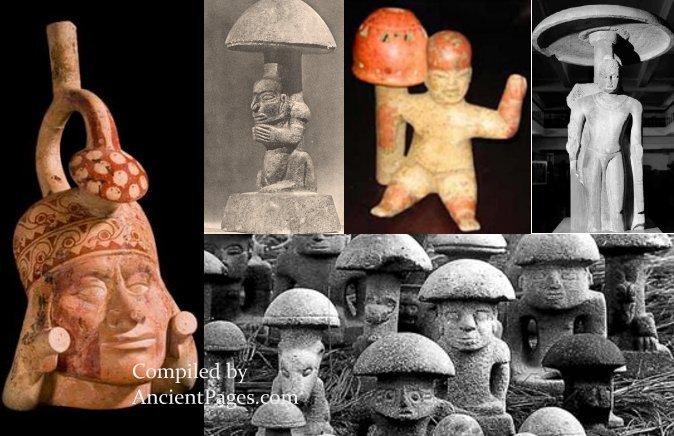Mysterious Ancient Mushrooms In Myths And Legends: Sacred, Feared And Worshiped Among Ancient Civilizations
Ellen Lloyd - AncientPages - Many ancient texts, legends, and myths mention sacred old mushrooms vital to our ancestors. Ancient civilizations admired, feared, and even worshipped mushrooms.
Because of their mysterious biology, mushrooms have attracted our interest since ancient times. How ancient people could distinguish between poisonous and edible mushrooms is unclear.
According to researcher Carl de Borhegyi, the word mushroom goes back centuries and was never precisely defined. The term "mushroom" and its variations may have been derived from the French word' mousseron' in reference to moss (mousse). Mushrooms are classified as plants, but they do not have chlorophyll.
Chlorophyll is the green substance in plants that, through photosynthesis, produces plant food from sunlight.
The scientific name is fungi, from the Greek Mykes and, although part of the plant kingdom, their reproduction is by spores, microscopic cells that the fungus leaves fall to the ground in huge quantities.
Mushroom Mythology: Ancient Beliefs About Mushrooms And Their Connection To The Sons Of The Gods
The ancient Egyptians, for example, believed there was a special connection between mushrooms and gods. Ancient Egyptians said wild mushrooms were the "sons of the gods" sent to Earth by lightning. Only the Pharaohs were therefore allowed to eat them.
 Image credit: Carl de Borhegyi - www.mushroomstone.com
Image credit: Carl de Borhegyi - www.mushroomstone.com
Ancient Egyptian hieroglyphs reveal that Pharaohs thought mushrooms were sacred herbs you could consume to become immortal.
Ancient Greeks were less enthusiastic about mushrooms. The Greeks feared mushrooms and considered them dangerous because they were poisonous. In Roman civilization, however, the fungus, while appreciated for its culinary qualities, became a symbol of death fungus. The term means "bringer of death" (from the Latin funus = death and needle = port, lead).
The Enigmatic Mushroom Stones Of Mesoamerica
In Mesoamerica, there was a mushroom cult. We come across many ancient statues depicting humans or gods made in the likeness of mushrooms. Some researchers have suggested the stones might represent a narcotic mushroom cult in Mesoamerica, but no evidence such a cult ever existed.
 The Preclassic Mayan mushroom stone pictured at the far left is from the site of Kaminaljuyu in the Guatemala Highlands, which depicts a mushroom emerging from the back of a crouching jaguar. Mushroom stones with a double edge or groove on the underside of the cap, have been dated to the Late Pre-Classic period about 300-100 B.C. by Stephan F. de Borhegyi based on the few mushroom stones that have been excavated in context at Kaminaljuyu. Image credit: Carl de Borhegyi - www.mushroomstone.com
The Preclassic Mayan mushroom stone pictured at the far left is from the site of Kaminaljuyu in the Guatemala Highlands, which depicts a mushroom emerging from the back of a crouching jaguar. Mushroom stones with a double edge or groove on the underside of the cap, have been dated to the Late Pre-Classic period about 300-100 B.C. by Stephan F. de Borhegyi based on the few mushroom stones that have been excavated in context at Kaminaljuyu. Image credit: Carl de Borhegyi - www.mushroomstone.com
The mushroom stones can be found in Mexico, Guatemala, and other places in America. For some unknown reason, the mushroom stones ceased to be made centuries before Columbus arrived on the shore of America.
"In examining these mushroomic artifacts, we must remember that they were not made for our enlightenment. They were iconic shorthand summarizing a whole bundle of associations, whatever those associations were.
The Christian cross is to be found in endless shapes, including the "effigy cross" or crucifix, and all stem back to a complex of emotions, beliefs, and religious longings.
 Ancient mushroom stones in Pre-Columbian art. Image credit: Image credit: Carl de Borhegyi - www.mushroomstone.com
Ancient mushroom stones in Pre-Columbian art. Image credit: Image credit: Carl de Borhegyi - www.mushroomstone.com
The crucifix would reveal to an archaeologist eons hence more than, say, a Maltese cross. So with the mushroom stones, the subject matter of the effigies holds the secret," late Ethno-Mycologist Robert Gordon Wasson said.
Experts who have studied the mushroom cult in Mesoamerica have found evidence both the hallucinogenic Amanita muscaria mushroom and the Psilocybin mushroom were worshiped and venerated as gods in ancient Mesoamerica.
These sacred mushrooms were cleverly encoded in the religious art of the New World, and we must look very closely to find the mushroom depictions.
Soma Is A Mysterious Plant Mentioned Over 100 Times In Rig Veda – Was It A Mushroom?
Scholars still debate the true identity of the mystery plant mentioned over 100 times in the Rig Veda called Soma. The Rig Veda describes Soma as a small red plant with no leaves, lacking roots and blossoms, but having a juicy and meaty stem.
 Ancient mushroom stones discovered in the Maya tomb. Image credit Carl de Borhegyi - Mushroom Stone
Ancient mushroom stones discovered in the Maya tomb. Image credit Carl de Borhegyi - Mushroom Stone
It is the only plant/beverage known to have been worshiped in the history of human culture. While the hymns about Soma have come down to us through time, the botanical identity of Soma remains a mystery.
Was Soma perhaps a mushroom?
Soma (Soma) was considered the most precious liquid in the universe. It was therefore, an indispensable aspect of all Vedic rituals, used in sacrifices to all gods, particularly Indra, the warrior god. Supposedly, gods consumed the beverage to sustain their immortality.
In this aspect, Soma is similar to the Greek ambrosia (cognate to amrita) because it was what the gods drank and what helped make them deities. Indra and Agni (the divine representation of fire) are portrayed as consuming Soma in copious quantities.
In both Iranian and Vedic Hindu mythology, the haoma and soma plant grow beneath a sacred and mighty "world tree". Image credit Carl de Borhegyi - Mushroom Stone
In his book Soma of the Aryans, Robert Gordon Wasson writes: "What was this plant called "Soma"? No one knows. Its identity was lost some 3,000 years ago when the priests abandoned its use.
The earliest liturgical compositions of the Indo-Aryans are called the Brahmanas.
They discuss the surrogates used for Soma in the ritual but fail to describe the original plant.
Soma was a mushroom, Amanita muscaria (fly agaric or fly amanita). This flaming red mushroom with white spots flecking its cap is familiar throughout northern Europe and Siberia.
Until lately, it has been a central feature of the worship of numerous tribes in northern Siberia, where it has been consumed in the course of their shamanic sessions.
 Image credit: Carl de Borhegyi - www.mushroomstone.com
Image credit: Carl de Borhegyi - www.mushroomstone.com
Its reputation as a lethal plant in the West is, I contend, a splendid example of a tabu long outliving the religion that gave rise to it. Among the most conservative users of the fly-agaric in Siberia, the belief prevailed until recent times that only the shaman and his apprentice could consume the fly-agaric with impunity: all others would surely die.
This is, I am sure, the origin of the tabu that has survived among us down to our day."
Archaeological evidence shows that hallucinogenic mushrooms - dating back to the Paleolithic period - were used in mysterious and religious rituals.
The Amanita muscaria was used collectively among the Siberian peoples at ceremonies and parties. The Shamans also used it to contact the spirits of the dead, in divination, and in interpreting dreams.
The widespread tradition of the use of medicinal mushrooms comes from the East, from the Taoist tradition of TCM (Traditional Chinese Medicine).
Mushrooms were also used as medicine in ancient times. In Eastern Europe, mushrooms are a vital part of the diet used for medicinal purposes. As we have seen mushrooms play a significant role in our ancestors' lives, we find ancient mushroom-related symbolism worldwide.
If you want to learn more about how important mushrooms were in ancient times, we recommend you read Carl de Borhegyi's excellent research.
Written by Ellen Lloyd – AncientPages.com
Updated on January 6, 2024
Copyright © AncientPages.com All rights reserved. This material may not be published, broadcast, rewritten or redistributed in whole or part without the express written permission of AncientPages.com
More From Ancient Pages
-
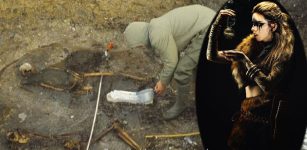 Mysterious Viking Gerdrup Grave – Burial Place Of Sorceress Katla And Her Son Odd Mentioned In The Eyrbyggja Saga?
Featured Stories | Mar 22, 2023
Mysterious Viking Gerdrup Grave – Burial Place Of Sorceress Katla And Her Son Odd Mentioned In The Eyrbyggja Saga?
Featured Stories | Mar 22, 2023 -
 1500-Year-Old Mystery Of The Sandby Borg – Excavation Of Ringfort On Öland, Sweden
News | Jan 1, 2014
1500-Year-Old Mystery Of The Sandby Borg – Excavation Of Ringfort On Öland, Sweden
News | Jan 1, 2014 -
 Unusual Ancient Skeletons Found In Minnesota – But Some Are Not What They Seem
Archaeology | Dec 10, 2024
Unusual Ancient Skeletons Found In Minnesota – But Some Are Not What They Seem
Archaeology | Dec 10, 2024 -
 600-Year-Old Axe Heads Used In The Battle Of Grunwald Found in Poland
Archaeology | Sep 1, 2020
600-Year-Old Axe Heads Used In The Battle Of Grunwald Found in Poland
Archaeology | Sep 1, 2020 -
 Subterranean Kingdom Of Shahmaran And The Land Of The Snakes
Featured Stories | Aug 17, 2020
Subterranean Kingdom Of Shahmaran And The Land Of The Snakes
Featured Stories | Aug 17, 2020 -
 On This Day In History: Britain’s Greatest War-Time Leader Winston Churchill Died In London – On Jan 24, 1965
News | Jan 24, 2017
On This Day In History: Britain’s Greatest War-Time Leader Winston Churchill Died In London – On Jan 24, 1965
News | Jan 24, 2017 -
 Ancient Roman Coins Discovered In Utah Could Re-Write History But Are They Authentic?
Archaeology | Apr 23, 2019
Ancient Roman Coins Discovered In Utah Could Re-Write History But Are They Authentic?
Archaeology | Apr 23, 2019 -
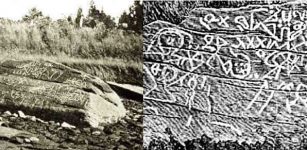 Dighton Rock – Centuries-Old-Mystery Still Unsolved
Featured Stories | Sep 8, 2015
Dighton Rock – Centuries-Old-Mystery Still Unsolved
Featured Stories | Sep 8, 2015 -
 ‘Wheel Of Giants’: Mysterious Complex Of Circles – Prehistoric ‘Stonehenge’ Monument In The Middle East
Featured Stories | Mar 29, 2019
‘Wheel Of Giants’: Mysterious Complex Of Circles – Prehistoric ‘Stonehenge’ Monument In The Middle East
Featured Stories | Mar 29, 2019 -
 MaizeCODE Sheds Light On How Corn Was Domesticated 9,000 Years Ago
Archaeology | Feb 14, 2025
MaizeCODE Sheds Light On How Corn Was Domesticated 9,000 Years Ago
Archaeology | Feb 14, 2025 -
 Rock-Cut Chambers In “House of Muses” Of Zeugma, Home To Numerous Mosaics
Archaeology | Jul 27, 2021
Rock-Cut Chambers In “House of Muses” Of Zeugma, Home To Numerous Mosaics
Archaeology | Jul 27, 2021 -
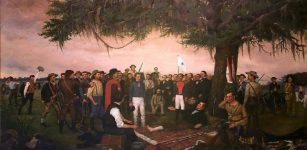 Texas Revolution – A Courageous Fight For Independence
Featured Stories | May 30, 2019
Texas Revolution – A Courageous Fight For Independence
Featured Stories | May 30, 2019 -
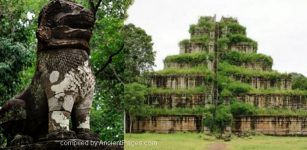 Water Storage Failure And Short-Lived Koh Ker Capital Of Khmer Empire
Archaeology | Nov 1, 2019
Water Storage Failure And Short-Lived Koh Ker Capital Of Khmer Empire
Archaeology | Nov 1, 2019 -
 Mysterious Hieroglyphs Point To The Location Of Queen Nefertiti’s Tomb?
Archaeology | Sep 29, 2022
Mysterious Hieroglyphs Point To The Location Of Queen Nefertiti’s Tomb?
Archaeology | Sep 29, 2022 -
 Saint Botvid – Viking Who Was Killed By A Slave He Granted Freedom
Featured Stories | Apr 10, 2023
Saint Botvid – Viking Who Was Killed By A Slave He Granted Freedom
Featured Stories | Apr 10, 2023 -
 Ancient DNA Yields Surprising Findings On World’s Earliest Seafarers
Archaeology | Jun 30, 2022
Ancient DNA Yields Surprising Findings On World’s Earliest Seafarers
Archaeology | Jun 30, 2022 -
 Great And Never Explained Mysteries Of Nevada’s History
Ancient Mysteries | Jun 24, 2014
Great And Never Explained Mysteries Of Nevada’s History
Ancient Mysteries | Jun 24, 2014 -
 January 2016: Lost Library Of John Dee Revealed In A Special Exhibition
Archaeology | Jan 24, 2016
January 2016: Lost Library Of John Dee Revealed In A Special Exhibition
Archaeology | Jan 24, 2016 -
 India’s Mysterious Stonehenge: Prehistoric Complex Of Gigantic Standing Stones Of Willong Is An Enigma
Featured Stories | Jul 30, 2016
India’s Mysterious Stonehenge: Prehistoric Complex Of Gigantic Standing Stones Of Willong Is An Enigma
Featured Stories | Jul 30, 2016 -
 New Study Challenges Theories Of Earlier Human Arrival In Americas – Archaeological Evidence Has Been Misinterpreted – Scientists Say
Archaeology | Apr 21, 2022
New Study Challenges Theories Of Earlier Human Arrival In Americas – Archaeological Evidence Has Been Misinterpreted – Scientists Say
Archaeology | Apr 21, 2022

